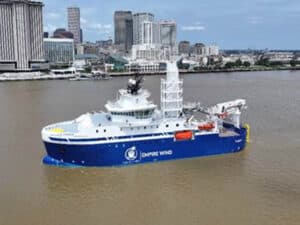
British canal boat completes three years of fuel-cell operation
Written by The U.K.’s University of Birmingham has been operating a canal boat with a fuel cell drive for three years on Britain’s 3,500 km long canal system.
The U.K.’s University of Birmingham has been operating a canal boat with a fuel cell drive for three years on Britain’s 3,500 km long canal system.
Last year the boat made its longest voyage to date, of four days duration and 105 km length, negotiating no less than 58 locks.

The boat, the Ross Barlow, demonstrates how a combination of magnet and fuel cell technologies can be effectively employed to power inland waterways craft. The Ross Barlow was created by converting a standard maintenance boat donated to the university by British Waterways. The diesel engine was replaced by a zero emission propulsion system comprising a high efficiency electric motor, a battery pack for short-term energy supply and a fuel cell with a hydrogen storage system to charge the batteries. In addition the ship is fitted with a solar panel which can supply up to 320 W of electric power.
The hydrogen is stored in a large scale metal hydride storage system which was developed in conjunction with EMPA laboratories, Zurich, Switzerland. It provides an effective means of storing large amounts of hydrogen at room temperature and at a modest pressure of around 10 bar. The hydrogen is released from the hydride simply by decreasing the pressure, providing the proton exchange membrane (PEM) fuel cell with an ultra pure source of hydrogen, thus extending the life of the fuel cell. The metal hydride powder weighs 130 kg and is thought to be the largest store of this kind in the UK.
Longer term aims of the project include the development of a hydrogen refueling infrastructure throughout the waterways and to generate green hydrogen on suitable sites throughout the network.
The first task to be done in converting the 18 m long steel-hulled barge was to calculate the power requirements. Based on experience with other battery driven canal boats it was decided to use a 10 kW permanent magnet motor. To provide energy for longer trips a commercial fuel cell delivering 1 kW of power was chosen. This system was originally designed as an uninterruptible power supply (UPS) for use in the telephone industry. The capacity of the fuel cell was, however insufficient to power the boat directly, so the “Ross Barlow” was also fitted with a 47 kWh buffer battery. Lead acid batteries were used for this purpose since they are low maintenance, low-priced and easy to charge. The weight of the battery pack is of no consequence when used in an inland waterways vessel.

The hydride storage system developed by Empa was partly financed by the Swiss Federal Office of Energy (SFOE). This device can store hydrogen with an energy content of 50 kWh, which is equivalent to 20 pressurized gas cylinders each of 10 liters capacity. The storage material consists of an alloy of titanium, zirconium, manganese, vanadium and iron in powder form which is packed into sealed steel tubes. The powder absorbs hydrogen, thus acting as a storage medium, only releasing it when heated. Since when “filling up” with hydrogen the metal powder generates heat which must be removed, each storage module is located in a water tank which can be warmed or cooled as necessary.
The journey through canals and locks makes widely varying demands on the boat’s electrical supply. To save wear and tear on the fuel cell, the motor draws its current from the lead acid batteries during routine sailing. A typical journey takes 4 to 6 hours during which time the canal boat uses 12 to 18 kWh of power. In continuous operation the fuel cell delivers 24 kWh of energy per day. This also powers the electronic monitoring system, leaving about 19 kWh with which to charge the buffer battery pack – enough energy for a daily journey lasting six hours. The reliability and operational lifetime of the metal hydride storage system was tested in the laboratory during its development. In practical terms this means that if the boat is assumed to travel 650 km per year through the British canal system, it would need refueling once a month with hydrogen. In this case the hydrogen storage system would have an operating lifetime in excess of 100 years, and would therefore comfortably outlast the useful lifetime of the barge itself.
The results of the test voyage During the 105 km, four-day summer test journey a total of 106 kWh of electric energy was consumed on the boat, including lighting and recharging the crew’s mobile telephones and laptop computers. The batteries supplied 71 percent of this energy, the hydrogen fuel cell 25 per cent and the solar panel 4 per cent.
There was unanimous praise from the crew for the practically silent way the boat sailed. Also notable was that when waiting in a lock the “Ross Barlow” was not engulfed by its own diesel fumes. A conventionally powered boat that accompanied it (which was about the same size) used some 50 liters of diesel, resulting in a CO2 emission of approximately 133 kg. The “Ross Barlow” on the other hand produced no CO2 during its voyage, assuming that the hydrogen it used was derived from renewable sources and delivered free of emissions to the refueling point on the bank of the canal.
August 29, 2011





Leave a Reply
You must be logged in to post a comment.